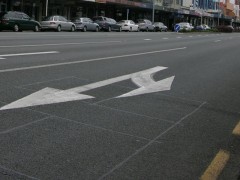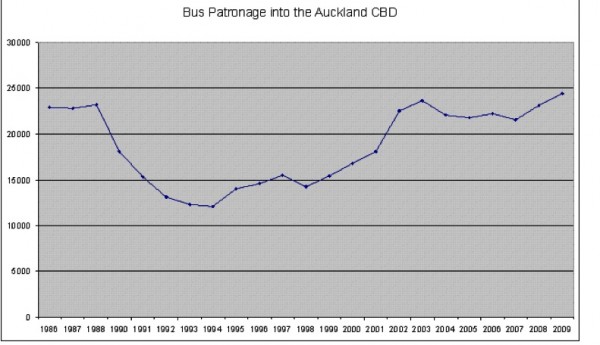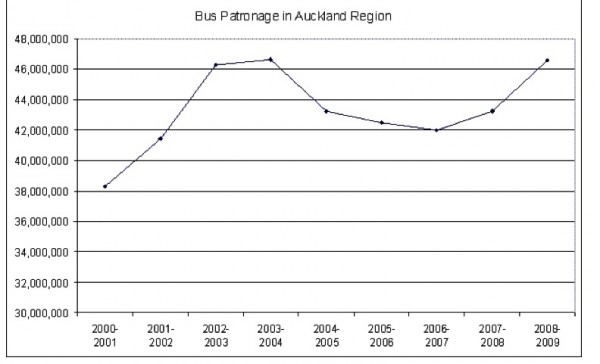AuckCity Defends Bus Lane Fines
 After a week-long barrage by the Royal New Zealand Herald about motorists being fined for entering bus lanes too quickly before turning left, Auckland City Council is fighting back.
After a week-long barrage by the Royal New Zealand Herald about motorists being fined for entering bus lanes too quickly before turning left, Auckland City Council is fighting back.
It’s staunchly defending its policy of fining motorists who stray into the bus lanes stray before 55m.
Transport general manager Penny Pirrit, who has become the frontperson for the council on this issue, continues to insiste the council’s primary aim is “to keep public transport moving, not to make money.”
“We’ve listened to people saying they are not sure how long 50m is,” she says. “We will be looking at the practicality of introducing static signs to advise drivers that bus lane cameras are in operation – in much the same way as there are signs for speeding and red-light cameras.”
“But these days it’s not enough for people to say they didn’t know about bus lanes,” she says. “Bus lanes have been around for years, they support our public transport system, help ease congestion, and the use of them is governed by the Road User Rule established by the NZTA.
“The vast majority of drivers respect the bus lanes – over the past three years compliance has not fallen below 98 per cent. Or to say it another way, infringements have not gone above 2 per cent.”
Penny Pirrit says that bus lanes are essential to Auckland’s transport strategy and while by law the council cannot alter how bus lanes operate, it”can ensure people are treated fairly by reviewing any complaints on a case-by-case basis.”
“We would rather increase the compliance than increase revenue. The winners are the people who use buses, and in conjunction with ARTA, we are finally enticing more people than ever away from their cars.”
Penny Pirrit says the council has always investigated complaints on a case-by-case basis and waives tickets where drivers have genuine reasons. In the case of Grafton Bridge, when the bus lanes were new, up to 30 per cent of tickets were waived.
In addition, drivers are not given a ticket unless they stray into a lane for more than 55m.
Here are the council’s backgrounders to justify its case:
Bus lanes
Bus lanes play an essential role in reducing Auckland’s traffic congestion by helping buses get where they need to go faster and more efficiently.
• Bus lanes separate buses from other traffic, enabling them to bypass traffic congestion, reducing conflict between buses, bikes and general traffic. Bus lanes also mean buses have shorter journey times and can keep to their timetables.
• About 36km of bus lanes have been introduced in Auckland city since 1997 and bus patronage has increased over that time period (as well as additional services coming online – see below for bus patronage figures).
Bus lanes – the rules:
• The vehicle categories permitted to use bus lanes are buses, cycles, mopeds and motorcycles. All other vehicles should only use bus lanes for the purposes of completing a safe turning manoeuvre or entering and exiting a driveway.
• You may cross a bus lane to make a turn using the minimum length necessary at the time and using no more than 50 metres. The location of a bus lane camera is not an indication of the 50-metre mark. This rule was part of the Road User Rule changes that came into effect on 1 November last year, the same group of changes that saw handheld mobile phones banned while driving). It is a national rule, as determined by the NZTA.
Bus lanes – enforcement:
• Over the past three years, compliance has not fallen below 98 per cent – infringements have not gone above per cent.
• The council’s role is to increase compliance with parking and traffic regulations. Revenue is a by-product of non-compliance.
• Auckland City Council is committed to keeping cars out of bus lanes, to ensure bus lanes operate as effectively as possible.
• Enforcement officers can issue infringement notices to vehicles incorrectly using bus lanes. The enforcement officers have received specialist training and been certified by the Commissioner of Police.
• On each bus lane, enforcement areas have been set up to monitor compliance. Each of these enforcement areas has been measured and is more than 50m in length. If a vehicle is driven through the entire enforcement area, an infringement notice may be issued.
• The enforcement officers take video footage of each offence. This is secondary evidence only, as the officer’s observation of the offence is the primary evidence.
Bus lanes – reviewing infringements:
• Auckland City Council seeks to be fair in relation to infringement offences and, when requested, considers the circumstances in which the infringement notice was issued. In some cases, the council may choose not to pursue the infringement any further.
• Council staff take several factors into consideration, including the law, the impact on other road users, the facts on the infringement notice and the circumstances outlined in the submission. We also look at supporting documents such as photographs, witness statements and delivery documents.
Bus lanes – the figures:
Revenue ($m) as of 30 June 2010: this is the net revenue (in $m) delivered to council from tickets issued in the year in question.
Year of ticket issue / WOF/
Registration / Parking tickets Bus lanes / Total /
2007-2008 / 6.2 / 8.0 / 2.5 / 16.7
2008-2009 / 6.3 / 7.8 / 2.9 / 17.0
2009-2010 / 4.1 / 5.3 / 3.3 / 12.7
NB: this is revenue received to date – receipts continue to come in over next two to three years.
Parking officer numbers
Year / Bus lane officers / Other officers in the field / Total
2006-2007 / 7 / 57 / 63
2007-2008 / 7 / 58 / 65
2008-2009 / 9 / 74 / 83
2009-2010 / 11 / 68 / 79
Source: end-July rosters for each year.
* Active officers available for clearway and general parking duties.
There are a small number of officers who work the night shift and Sundays, mainly in the CBD but also in response to customer requests for service in the suburbs. There are eight on roster for Thursday, Friday and Saturday nights and during Sunday, and three on roster for the rest of the week. Officers will issue tickets for parking infringements, and expired warrant of fitness and registration as they come across them.
Bus patronage:
• Generally, bus lanes significantly increase reliability for buses when they are first introduced, and, when combined with service frequency increases, large increases in patronage can result. For example, the Dominion Road patronage increased by more than 80 per cent from 1997 to 2004 after bus lanes were introduced in 1997/1998 and services increased over the two-hour morning peak from 25 to 40.













1 Comments
Well, that was needed. Thank you.
Though it is ironic to see them lauding bus lanes (specifically mentioning Dom Road lanes!) and then change them into T2 lanes.
Who wants to bet that with T2 lanes, non-compliance will be higher than 2%, and we will be reading a lot in the “Aucklander” and the “Herald” and wherever about the poor wronged motorists caught using them “illegally”…
Please, Council - save yourself that grief. Like in any negotiation or public interaction, there’s a difference between standing your ground and being unreasonable, between listening to reason and caving in. I hope Council knows that the best way to go is to do just what this response does - tell them firmly why you are doing things, and then ignore the whingers.